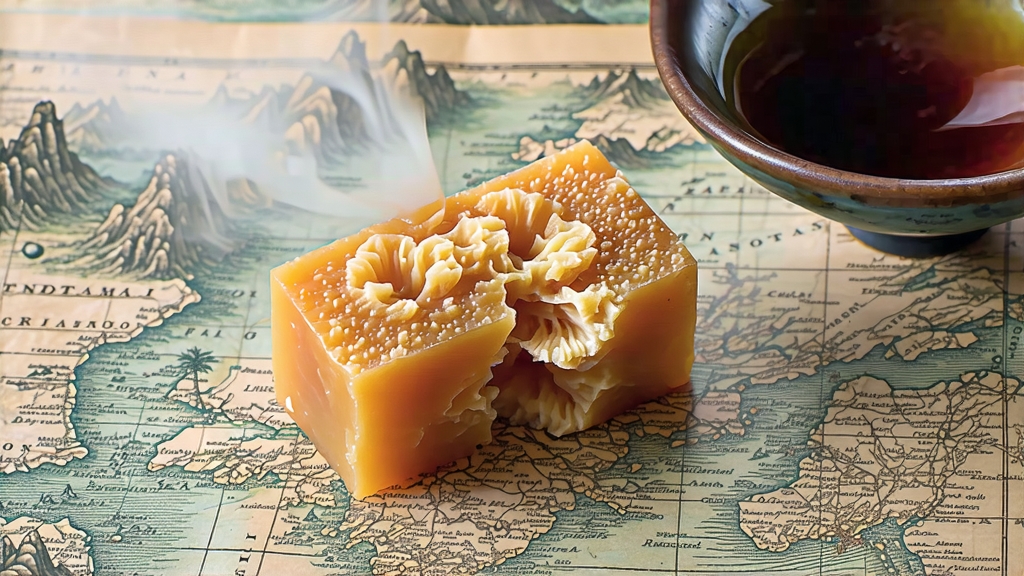
Among the six great families of Chinese tea, dark tea—hei cha—remains the least understood outside Asia, yet it once underwrote the economics of the Silk Road and still carries the flavors of caravans, yak butter, and centuries of cellar-like patience. Within hei cha, no style better embodies this marriage of commerce, microbiology, and time than Fu brick tea, a pressed, post-fermented brick originally created to keep soldiers and traders alive on the 3,000-kilometre journey from Hunan to Lhasa. Today the same micro-fungi that once prevented spoilage have become the object of scientific fascination and the source of a mellow, honeyed liquor prized by collectors from Beijing to Brooklyn.
1. Historical footprint
The name “Fu” refers to the imperial “Fu” county in Shaanxi where bricks were first stamped during the late Ming dynasty (c. 1368). Government records from 1524 show that tea taxes were paid in bricks because compressed leaves resisted humidity and bandits alike. When the Qing court formalized the Tea-Horse Road, Fu brick became legal tender; one 1.2 kg brick could be bartered for 120 kg of Tibetan horses. Caravans carried the tea across the Yellow River, up to 4,000 m elevations, and the bricks absorbed yak-butter smoke, cold nights, and months of yak-saddle pressure—accidental aging that later connoisseurs would try to replicate in climate-controlled caves.
2. Terroir and leaf grade
Authentic Fu brick starts with Hunan’s large-leaf cultivar Yun-da-zhong, grown at 600–800 m in the misty Wuling Mountains. After the spring harvest, leaves are sorted into five grades; only the third and fourth—mature enough to resist compression yet still rich in soluble sugars—are chosen. The high ratio of stems (up to 20 %) provides natural air channels that allow Eurotium cristatum to breathe during the critical flowering stage.
3. Crafting the brick: a 12-month choreography
Making Fu brick is less a recipe than a dialogue with microbes.
Step 1: Pan-fire fixing
Leaves are tossed in 280 °C woks for 90 seconds to destroy leaf enzymes, but the operation is deliberately lighter than green-tea fixing so that microbial substrates remain intact.
Step 2: Rolling & piling
After rolling, the damp leaves are piled 70 cm high under wet cotton cloths for 4–6 hours. This short “wet piling” pre-conditions the leaf surface for later fermentation without developing the heavy earthy notes of Yunnan shou pu-erh.
Step 3: Stacking into bricks
The preconditioned maocha is steamed for 8 seconds, then packed into 1 kg wooden molds lined with breathable rice paper. A hydraulic press exerts 25 tonnes of pressure for precisely 90 seconds—long enough to bind the brick, short enough to leave micro-cavities.
Step 4: The golden flower bloom
Bricks are transferred to the “Fa-hua” room, 28 °C and 75 % RH, and stacked like library books with 2 cm gaps. Over 15–20 days the spores of Eurotium cristatum germinate, forming tiny golden spots visible to the naked eye. Locals call them “golden flowers” (jin hua); laboratory assays show they produce unique cyclo-protocatechuic acid that lowers blood lipids and imparts a faint apricot aroma. The flowering period is the soul of Fu brick; bricks that fail to bloom are rejected or sold as low-grade “dark brick.”
Step 5: Drying & resting
After blooming, bricks are slowly dried at 45 °C for seven days, then rested in ventilated warehouses for a minimum of six months. During this time oxidative enzymes decline, caffeine complexes with polyphenols, and the liquor softens from rough astringency to syrupy smoothness.
4. Variations within Fu brick
- Traditional Fu: 1 kg rectangular brick, golden-flower coverage ≥ 20 %, pressed in bamboo-coated molds.
- Mini Fu: 100 g “chocolate-bar” segments introduced in 2008 for urban millennials; same process, faster drying.
- Vintage Fu: